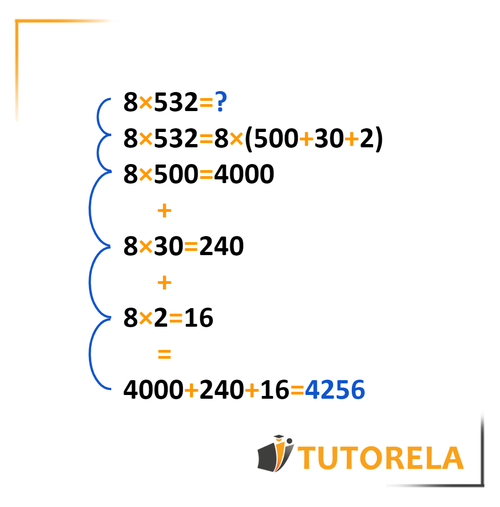The distributive property of multiplication allows us to break down the highest term of the exercise into a smaller number. This simplifies the multiplication operation and we can solve the exercise without the need to use a calculator.
Distributive Property Practice Problems for 7th Grade Math
Master the distributive property with step-by-step practice problems. Learn to multiply and divide using distribution for easier calculations in 7th grade math.
- Apply distributive property to simplify multiplication problems with large numbers
- Break down complex numbers into smaller, easier-to-calculate components
- Use distributive property with addition and subtraction in parentheses
- Solve division problems using distributive property techniques
- Calculate expressions like (40+70+35-7)×9 step by step
- Master both a×(b+c) and (a+b)÷c distributive forms
Understanding The Distributive Property in the Case of Multiplication
Example of an exercise where the distributive property is applied with multiplications
Let's assume we have an exercise with a multiplication that is simple, but with large numbers, for example:
Thanks to the distributive property, we can break it down into simpler exercises:
+
+
=

Practice The Distributive Property in the Case of Multiplication
\( 35\times4= \)
Examples with solutions for The Distributive Property in the Case of Multiplication
Solve the exercise:
84:4=
There are several ways to solve the following exercise,
We will present two of them.
In both ways, we begin by decomposing the number 84 into smaller units; 80 and 4.
Subsequently we are left with only the 80.
Continuing on with the first method, we will then further decompose 80 into smaller units;
We know that:
And therefore, we are able to reduce the exercise as follows:
Eventually we are left with
which is equal to 20
In the second method, we decompose 80 into the following smaller units:
We know that:
And therefore:
which is also equal to 20
Now, let's remember the 1 from the first step and add it in to our above answer:
Thus we are left with the following solution:
Answer:
21
Solve the following exercise
?=24:12
Apply the distributive property of division and proceed to split the number 24 into a sum of 12 and 12, which ultimately renders the division operation easier and allows us to solve the exercise without a calculator.
Note - it's best to choose to split the number based on knowledge of multiples. In this case of the number 12 because we need to divide by 12.
Reminder - The distributive property of division actually allows us to split the larger term in a division problem into a sum or difference of smaller numbers, which makes the division operation easier and allows us to solve the exercise without a calculator
We will use the formula of the distributive property
Therefore the answer is section a - 2.
Answer:
2
Solve the following exercise
?=93:3
We will use the distributive property of division and split the number 93 into a sum of 90 and 3. This ultimately renders the division operation easier and allows us to solve the exercise without a calculator.
Note - it's best to choose to split the number based on knowledge of multiples. In this case, we use 3 because we need to divide by 3. Additionally splitting by tens and ones is suitable and makes the division operation easier.
Reminder - The distributive property of division essentially allows us to split the larger term in the division problem into a sum or difference of smaller numbers, which makes the division operation easier and allows us to solve the exercise without a calculator
We will use the formula of the distributive property
Therefore, the answer is option B - 31.
Answer:
31
In order to simplify the calculation , we first break down 94 and 72 into smaller and preferably round numbers.
We obtain the following exercise:
Using the associative property, we then rearrange the exercise to be more functional.
We solve the exercise in the following way, first the round numbers and then the small numbers.
Which results in the following exercise:
Answer:
166
To solve the problem, first we will use the distributive property on the two numbers:
(60+3)-(30+6)
Now, we will use the substitution property to arrange the exercise in the way that is most convenient for us to solve:
60-30+3-6
It is important to pay attention that when we open the second parentheses, the minus sign moved to the two numbers inside.
30-3 =
27
Answer:
27